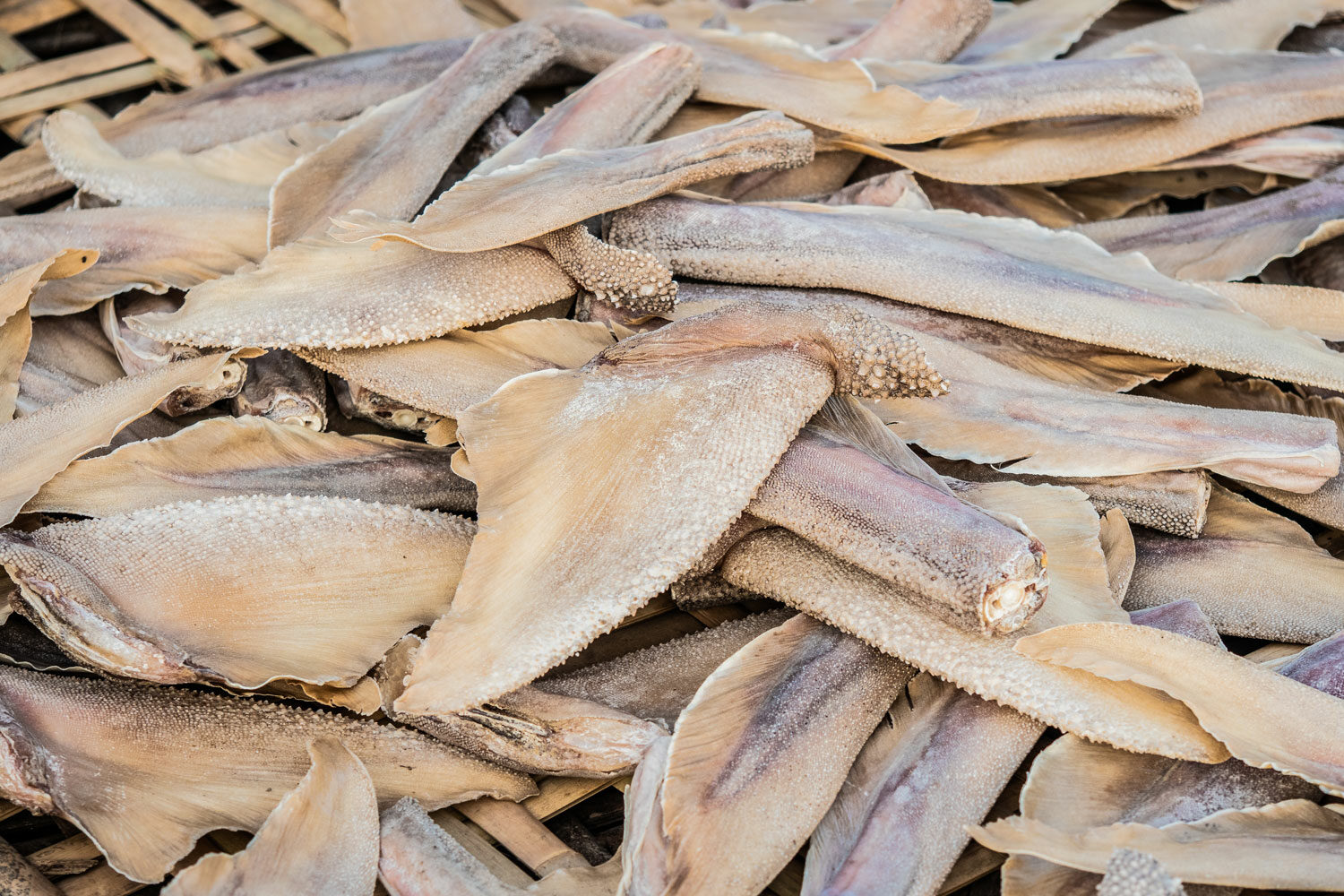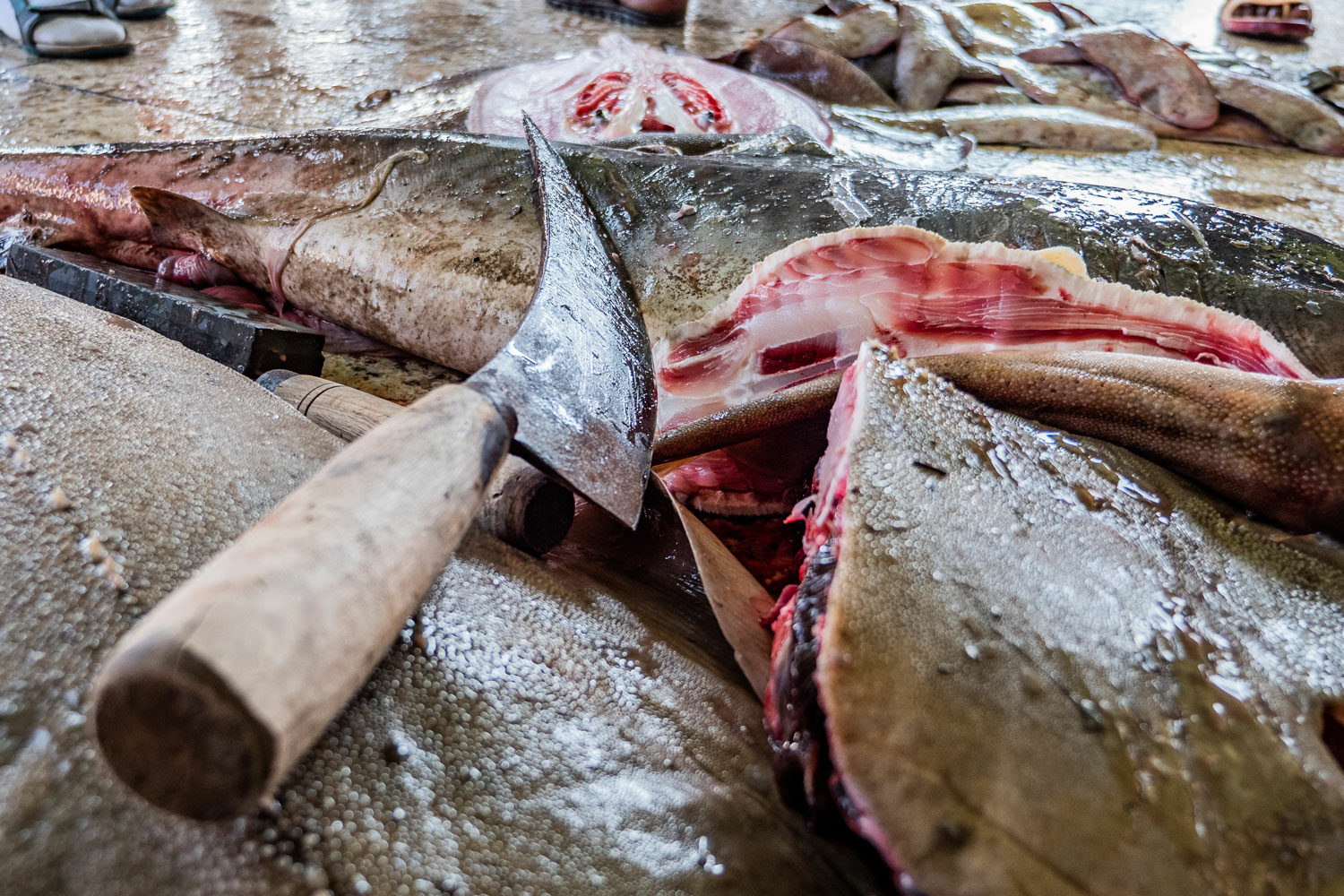Saving giants in the Bay of Bengal
For Alifa Bintha Haque, scouring fish landing sites in south-eastern Bangladesh for once-abundant sawfishes and guitarfishes has taken time, enormous effort and endless patience – and it’s just the beginning of her mission to protect these species.

Photos © Oliver Deppert
Cox’s Bazar is a blue and brown speck seen through the windows of our overnight bus. Quaint and sleepy in the morning sun, its tranquil appearance belies the secrets changing hands in its back alleys. It is hard to imagine that in the waters beyond where the tourists throng, creatures from yesteryear still swim: endangered sawfishes and guitarfishes, and mysterious sharks. The town, situated in the north-eastern corner of the Bay of Bengal, is a major tourism hub in Bangladesh and boasts the longest unbroken beach in the world. Beyond that shore lies a bountiful ocean, one that Bangladesh governs for 354 nautical miles out to sea. Nearly six million tons of fish are hauled from these waters each year – an astronomical number that corresponds to almost 4% of the total global catch. For the nearly 400 million people in the region, the waters are a lifeline. For scientist Alifa Bintha Haque, they are a source of endless questions – and the starting point for her mission to save the last of Bangladesh’s sawfishes.
When we visit, Cox’s Bazar is packed with Bengali families in joyful vacation mode. But there is no such frivolity for us. We are here to search the dingy establishments that run the length of the rivers snaking to the sea, trying to uncover a secretive trade in sharks and rays. We are especially interested in sawfishes and guitarfishes, which are highly vulnerable shark-like rays. Cox’s Bazar gives us a window into the exploitation of these slow-growing species, the undocumented trade in them and their consequent declines. And it is here, in the tawdry trading posts clinging to the riverbanks, that Alifa and her colleagues are looking for the answers to many questions. ‘Which sharks are traded?’ they ask. ‘And in what numbers? Where are they caught, and what is their value?’
Cox's Bazar is both a popular vacation destination for holidaying Bengali families and a busy fishing hub processing catches that are a lifeline for nearly 400 million citizens in the region. Photo © Oliver Deppert
In search of ocean giants
With scant scientific data available at the time and dozens of questions buzzing in her mind, Alifa sets about earning the trust of the local fishers. She spends hours sipping tea with them, listening intently to their stories while they repair their fishing nets. And her patience pays off: one fisherman surprises her with an invitation to join his boat. Locals believe a woman aboard a fishing boat brings bad luck, but Alifa’s hours of investment have secured for her a position of trust. As a token of good faith, one of the traders presents her with a sawfish rostrum nearly as tall as she is. It’s worth US$300. Small triumphs such as these give Alifa motivation to continue tracking the catch patterns, trade routes and natural history of sawfishes.
I have come to hear these stories at first hand. I want to meet these same fishers and watch some of Alifa’s experiences unfold before my eyes. And so I find myself gazing out of a bus window as Cox’s Bazar rouses itself in the tranquil morning light. With me are Alifa’s research assistant Mahi and Fayed, a photographer. Mahi is to be my eyes and ears for the next two days, filling me in on all the back stories and leading to me to sources – the shark traders, fishermen and dried fish processors.
We visit the fisheries ghat behind the tourist town, a chaotic site that, in all its madness, is barely still tethered to the sea and serves simultaneously as a fish market, landing site and storage zone. Established in the 1980s, the dilapidated building looms tall next to the Baghkhali River as it flows towards the Bay of Bengal. The unbelievable stench and noise hit me the moment I alight from the tomtom (a three-wheeled scooter that is the primary mode of transport here). Hundreds of artisanal trawlers dock daily and unload their catch at this site. We stand under the soft white sky while mayhem unfolds, the place abuzz with the cries of hundreds of fishermen, middlemen, workers, businessmen. Most are here to work, but some come to observe the drama unfolding or to sneak a piece of the fish being hurled around. We slosh through bloodied water past piles of fishes, moving through the mess of scales flying through the air.
It is not yet peak shark-fishing season. In fact, most of the market’s front section is dedicated to sorting and packaging freshly caught hilsha, Bangladesh’s national fish and the single most commercially important fish species here. But as we move to the back of the market I recoil in horror at the great, grey mounds of sharks and rays. This is Ground Zero, the corner of the ghat where sharks and rays are collected, preserved and distributed and where much of the trade in these species takes place. We watch fishermen unload their catches: hammerhead, pig-eye, tiger and spot-tail sharks, at least three different species of rays and, shockingly, Critically Endangered sawfishes and guitarfishes.
Cox's Bazzar from above. Photo © Oliver Deppert
From sea to slipway: where do Bangladesh’s sharks, sawfishes and rays go?
What happens to the sharks, rays, sawfishes and guitarfishes once they have been landed? It has taken Alifa three years of extensive interviewing to fathom this out. And we must follow her lead and start from the beginning. Bangladesh’s fisheries are dominated by men. Men are the traditional fishers in Bangladeshi culture and they have sailed these rough seas for more than 50 years. Every day for decades, they have gone to sea and returned with their hauls. Years ago, traders realised there was a demand for shark parts, and this insight became the catalyst for targeted shark and ray fishing and the ensuing trade. The sharks are caught and brought to landing sites, then processed in one of the five different centres that have operated for nearly 40 years in the seaside town.
It was a lucrative business at first, when the catch was bountiful. But even as the catches declined over the years, newer businesses continued to emerge; some of these have been in operation for nearly 25 years. Many are opportunistic, focusing on fish exports but trading shark fins and other shark products when the occasion arises, an arrangement encouraged by shark traders. One of the oldest of these in Chattagram (Chittagong), 150 kilometres (93 miles) to the north, started business in the 1960s after he learned about the shark trade from an American buyer. Since then he has been exporting shark fins and other products to Japan, China and the USA.
In Cox’s Bazaar I witness the network of trust that Alifa and her colleagues have built with local fishers and traders, who relay reports of sawfish catches by phone. The pioneer traders provide Alifa with a wealth of information as they scour the town, checking landing sites and assigning workers to purchase the sharks each day. But landing sites are not their only source of sharks and rays; sometimes they collect them from opportunistic middlemen or other buyers. The size of the fin, quality of the skin or weight of the shark are all considered in determining the catch’s price. Smaller sharks are set aside for drying while the larger ones are processed and distributed along a wide-ranging network of traders and exporters.
Photo © Oliver Deppert
The first sawfish
Buoyed by a 2012 study that revealed that at least two species of sawfish were still present in Bangladeshi waters, Alifa also heard stories of encounters with sawfishes. Abdul Gani, an artisanal fisherman, told her about catching a giant sawfish in the shallow coastal waters of south-western Bangladesh in 2015. ‘I had to call two other boats and 19 fishermen. We tried for hours to pull the giant out of the water. Then, as soon as we pulled it out, the sawfish gave birth to five pups. It was a giant of more than a ton in weight. When it’s in the water, you must fight for hours to catch such a majestic animal.’ The female and her pups were sold. Alifa recalls asking Abdul about the fate of those live pups. ‘I saw remorse in his eyes. This was my first ray of hope that if these fishers could be made aware of the plight of sawfishes, they could become conservation pioneers for the species in Bangladesh.’

Photos © Oliver Deppert
Stories like Abdul’s are Alifa’s inspiration for persisting in the search for sawfishes. She added more than 200 field days to her quest, continuing to scour all the landing sites and the fish markets for shark products. Her search was in vain, save for one find: a sawfish caudal fin and rostrum in one of the shark processing centres. But continued reports sent to her by traders now show that sharks and rays are landed in Chattagram, Teknaf and St Martin’s Island as well as in Cox’s Bazar, and in fishing ports in Barishal, Dublar Char in the Sundarbans and Khulna. She suspects that these landings are just a fraction of the bigger picture.
Photo © Oliver Deppert
A rapid decline in numbers
Sawfish catches have decreased, which is why many fishers say they no longer target them, but the rays are still accidentally caught by fishers using drift gill nets. When one does become ensnared in a net, fishers rarely have reason to voluntarily release it alive, even though the species’ numbers are dwindling, since sawfish products are associated with many uses. Nowadays, sawfish catches may be few and far between, but one of the local fishermen, who has worked from this market for nearly three decades, tells of huge sawfishes he brought in by the dozen in his youth. His tales may be boastful exaggerations, but the data still suggest that the decline is significant.
Bangladesh is a country of rivers, with productive estuaries, shallow coastlines and the largest mangrove forest in the world, the Sundarbans. The land receives a huge influx of sediments and nutrients, while the estuaries are unique ecosystems with potential to host key habitat for sawfishes. Four species are believed to have been historically present in Bangladesh: the largetooth, the smalltooth, the green and the narrow sawfishes. The first three are listed as Critically Endangered by the International Union for Conservation of Nature (IUCN) on its Red List of Threatened Species, while the narrow sawfish is Endangered. The largetooth sawfish is reported to be extinct in many of its former range states: its geographical range has contracted by 61% and its population has experienced a decline of 80% since the 1960s. The extent of occurrence of the narrow sawfish has declined by 30%.

Photo © Oliver Deppert
‘According to a survey of fishermen in the coastal areas of Bangladesh, the number of sawfish encounters in the past two decades has seen a rapid decline. In the late 1990s, sawfishes were abundant in the coastal areas, but now the catch is significantly lower,’ says Alifa. Over the years, this majestic creature of the ocean – it can grow to a length of seven metres (23 feet) – has entirely disappeared from 21 countries. Currently, sawfish species are protected in only 16 out of the 92 countries in which they are found. Overfishing in the Bay of Bengal, by both deep-sea vessels and artisanal trawlers, is the main threat identified by researchers in a paper titled ‘Sawfish exploitation and status in Bangladesh’. Even without targeted sawfish fishing, the very fact that fishing generally has escalated in the bay increases the likelihood that these rays will become bycatch. Once entangled in the nets, they are collected by the fishermen, who know that there is a demand for their products. This practice of illegal, unregulated and unreported fishing is, according to marine scientists, a major threat to marine life.
‘There is also a belief among villagers in the coastal areas in Bangladesh that the meat and different parts of a sawfish have medicinal properties,’ adds Alifa. ‘In fact, in some areas, sawfish parts are bought for really high prices because of their perceived health benefits, such as curing cancer. This superstition has created a demand for sawfish meat, which can be sold for up to US$35 per kilogram. But the local demand is quite limited because the catches are sporadic, so there is no dedicated market niche for sawfish products in the local markets.’
Three of the four sawfish species historically present in Bangladeshi waters – largetooth, narrow and green – are protected under the Wildlife Protection Act (2012) of Bangladesh and are also listed by the Convention on International Trade in Endangered Species (CITES) on Appendix 1. This listing prohibits international trade in sawfishes, except in extraordinary (and highly regulated) circumstances. But with few policing resources and multiple stakeholders in the trade to contend with, protecting and monitoring sharks and rays in practice is difficult. This appears to be a classic case of what noted conservationist Gerald Durrell said is giving an animal ‘paper protection’.
Photo © Oliver Deppert
Another threat looms
With little capacity for protection and monitoring, it is likely that more marine species will face the same fate as sawfishes in Bangladesh. At the top of the list are guitarfishes, the sawfishes’ close cousins. Noticing this species creeping into the catches, Alifa and her team started collecting detailed landing and trade data on guitarfishes too. When we visit the market together, we find eight guitarfishes. ‘This is alarming,’ cautions Alifa. ‘At one point, a large number of sawfishes were caught. But over the years that number dwindled to an average of one animal per month.’ The landings of guitarfishes at all life stages (adults, juveniles and pregnant females all make it past the slipway and into markets) could be a warning sign to take immediate measures – or guitarfishes will suffer the same fate as sawfishes.
Photo © Oliver Deppert
The fight for proactive measures
Over the years, Alifa has given everything to her work. But if the fishing community is to be included in conservation, and the sharks and rays of Bangladesh are to be effectively protected, it is this kind of concerted effort that is needed.
She suggests that conservation organisations in the region should work together to set short-term and long-term goals. From discussions, solutions emerge. For example, a culturally appropriate social marketing campaign to dispel the superstitions around sawfish meat is a low-cost effort with the potential for high impact. Fishing practices in the artisanal sector also need to change and demand for sawfish products has to be reduced. Alifa has launched an assessment of what barriers exist to fishers’ engagement in a live-release programme. She will use the information to create an incentive regime that encourages fishers to release sawfishes alive.
Alifa is inflexible in her belief that ‘resilience, support to achieve common goals, the strength of true empowerment and appropriate dialogue can solve problems that otherwise feel unachievable’. Her work sets an example for inclusive conservation measures in resource-poor countries. She also believes that the case of sawfish conservation can be a blueprint for the conservation of the guitarfish. If sustainable fishing practices can be implemented, then we can stave off the extinction storm.
We return to Dhaka, the country’s capital, with an understanding that action to stop trade should take precedence over further research. The volumes of fish being caught every day and the absence of sawfish catch hint that, without swift intervention, soon there may be no more sharks and rays to study at all.
Find the magazine online here or purchase Issue 11 of the Save Our Seas Magazine online here



